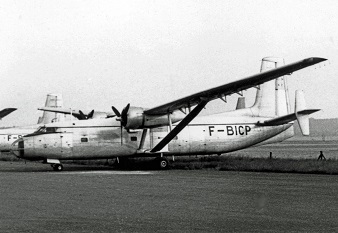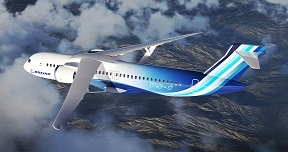Hurel-Dubois back in fashion?
Discussion
French company Hurel-Dubois pioneered truss-braced very high aspect ratio wings in the 1950s.
Hurel-Dubois used them on several of their own designs (HD.34 shown) and largely influenced the Short Skyvan/330/360 wing.

NASA and Boeing are working together to research and ultimately build a full-size demonstrator using a similar wing for transonic hybrid-powered regional airliners.
NASA/Boeing Truss-braced Wing Research

Hurel-Dubois used them on several of their own designs (HD.34 shown) and largely influenced the Short Skyvan/330/360 wing.

NASA and Boeing are working together to research and ultimately build a full-size demonstrator using a similar wing for transonic hybrid-powered regional airliners.
NASA/Boeing Truss-braced Wing Research

Not that the Hurel-Dubois was intended to be transonic.
The Hurel Dubois high aspect wing also made its way onto the Miles Aerovan and the Short Skyvan/Skyliner/S330/S360 family.
I remember seeing HD34 F-BICU when it was based in Dublin in 1972 and 1973. The French Institute Geographique used a couple of them as geophysical survey aircraft and the Irish government hired one to look for oil and gas off the Irish cost.
It used to fly over my house on a regular basis.

The Hurel Dubois high aspect wing also made its way onto the Miles Aerovan and the Short Skyvan/Skyliner/S330/S360 family.
I remember seeing HD34 F-BICU when it was based in Dublin in 1972 and 1973. The French Institute Geographique used a couple of them as geophysical survey aircraft and the Irish government hired one to look for oil and gas off the Irish cost.
It used to fly over my house on a regular basis.
Eric Mc said:
Not that the Hurel-Dubois was intended to be transonic.
The Hurel Dubois high aspect wing also made its way onto the Miles Aerovan and the Short Skyvan/Skyliner/S330/S360 family.
I remember seeing HD34 F-BICU when it was based in Dublin in 1972 and 1973. The French Institute Geographique used a couple of them as geophysical survey aircraft and the Irish government hired one to look for oil and gas off the Irish cost.
It used to fly over my house on a regular basis.

Looks very Cold War Soviet with that glazed nose.The Hurel Dubois high aspect wing also made its way onto the Miles Aerovan and the Short Skyvan/Skyliner/S330/S360 family.
I remember seeing HD34 F-BICU when it was based in Dublin in 1972 and 1973. The French Institute Geographique used a couple of them as geophysical survey aircraft and the Irish government hired one to look for oil and gas off the Irish cost.
It used to fly over my house on a regular basis.
Eric Mc said:
It also had a retractable nose wheel but fixed main wheels.
Perhaps that was to get the nosewheel out of the way of whatever sensors/cameras it was carrying.I recall seeing a Hurel-Dubois over Farnham in the late 1980s, and, I think, on the ground at Lasham sometime after. It could well be the same one you saw Eric.
Eric Mc said:
Traditionally, very high aspect ratoi wings were utilised in aircraft that had fairly low top speeds but which required extreme efficiency regarding lift and gliding ability. The novelty of this design is that it is intended to be transonic.
From what I've read about this project, the speed factor isn't the key consideration here. This is primarily about drag reduction - higher altitude flying (thinner air so less drag) and obviously lower drag from a HA wing design. The key driver being environmental / fuel cost reduction.Secondary to that being getting close to current speeds.
The other interesting engineering challenge is how you fit such a big wing in an airport not designed for it. Packaging folding in a HA wing is a challenge.
Some versions of the 777 have folding wingtips. I seem to remember this being an option on the very earliest 777s but the option wasn't taken up at the time. I think they are becoming more common now.
At the altitudes the U-2 flies, even with its high aspect, glider like wings, they often get very close to their Mach limits due to the thin air.
At the altitudes the U-2 flies, even with its high aspect, glider like wings, they often get very close to their Mach limits due to the thin air.
As we start edging away from kerosene fuel, the thick wings that double as fuel tanks will no longer be a necessity. If batteries or hydrogen are to be stored in a longer or larger fuselage, the wings can be thinner and more efficient in the cruise, providing the necessary strength can be achieved; hence the truss.
Airbus had already recognised twenty years ago that the existing conventional layout is not ideal for regional airliners. I went to a lecture at Filton when working there for them, in which their outline of the future single aisle airliner resembled an Ilyushin 76 but with engines on the rear fuselage BAC-111 style. The justifications for this layout were:
1. Fuselage close to the ground, so to dependent on waiting for airport steps to disembark.
2. Clean wing devoid of engine mountings and undercarriage for efficiency and simplified manufacture.
3. Engines on rear fuselage, so plenty of room for high bypass turbofans.
4. Wheels on fuselage and spar hump over cabin require slightly slower cruise, but made up for by not waiting for the steps.
Had the BAE 146/Avro RJ been continued, maybe it would have been evolved into something similar, however BAe were more intersted in making money from terrestrial military equipment and selling property than by building commercial aeroplanes.
Airbus had already recognised twenty years ago that the existing conventional layout is not ideal for regional airliners. I went to a lecture at Filton when working there for them, in which their outline of the future single aisle airliner resembled an Ilyushin 76 but with engines on the rear fuselage BAC-111 style. The justifications for this layout were:
1. Fuselage close to the ground, so to dependent on waiting for airport steps to disembark.
2. Clean wing devoid of engine mountings and undercarriage for efficiency and simplified manufacture.
3. Engines on rear fuselage, so plenty of room for high bypass turbofans.
4. Wheels on fuselage and spar hump over cabin require slightly slower cruise, but made up for by not waiting for the steps.
Had the BAE 146/Avro RJ been continued, maybe it would have been evolved into something similar, however BAe were more intersted in making money from terrestrial military equipment and selling property than by building commercial aeroplanes.
GliderRider said:
As we start edging away from kerosene fuel, the thick wings that double as fuel tanks will no longer be a necessity. If batteries or hydrogen are to be stored in a longer or larger fuselage, the wings can be thinner and more efficient in the cruise, providing the necessary strength can be achieved; hence the truss.
Kerosene, batteries or hydrogen, all are very heavy and bulky, so why does kerosene go in wings but the other two in the fuselage (using up payload space)?The truss seems to me 10% back to biplane; get some lift from it but support a thinner main wing too.
Simpo Two said:
Kerosene, batteries or hydrogen, all are very heavy and bulky, so why does kerosene go in wings but the other two in the fuselage (using up payload space)?
Kerosene goes in the wing because it is easy to do, keeps it near the centre of gravity and spreads the load in flight reducing metal fatigue. Hydrogen generally requires a pressure vessel, which results in a very thick blended wing if trying to incorporate it into an aerofoil. I don't know the answer for batteries, but I would hazard a guess that batteries don't like temperature extremes, so spread across a wing they may need heating or cooling, depending whether they are sitting overnight in Siberia or in the sun at midday in Saudi Arabia.
GliderRider said:
I don't know the answer for batteries, but I would hazard a guess that batteries don't like temperature extremes, so spread across a wing they may need heating or cooling, depending whether they are sitting overnight in Siberia or in the sun at midday in Saudi Arabia.
Batteries in the fuselage could be a nail in the coffin for commercial electric aeroplanes, even if it was feasible to start with, which I doubt. Not only does it lose money-earning space, but do you really want to be stuck in a tube at 30,000 feet with tons of lithium batteries? Not nice when they develop a fault.If the world really wants to lower CO2 emissions then jet air travel will simply be taxed beyond where ordinary people can afford it. The age of cheap (ie mass) air travel will be over, and become just another era in history.
Anyway, back to the plot...
I'm not an aerodynamiscist so not really sure what the overall effect long thin wings have on achieving high mach numbers. Generally, aircraft that are designed to have transonic or supersonic capability have been designed with short, braod wings.
Over the past few decades, the chord width of airliner wings have been getting narrower. It's worth looking at the wing chord of (say) a Boeing 707 or Caravelle versus an Airbus A320.
Over the past few decades, the chord width of airliner wings have been getting narrower. It's worth looking at the wing chord of (say) a Boeing 707 or Caravelle versus an Airbus A320.
Eric Mc said:
I'm not an aerodynamiscist so not really sure what the overall effect long thin wings have on acheiving high mach numbers.
As a general rule, the shorter the chord in relation to the thickness (ie. the thickness:chord ratio), the more the air flowing over it has to accelerate, hence the higher the localised Mach number.I'm sure you're aware of the issues that planes like the Hawker Typhoon and P38 Lightning had with compressibility, due to their relatively thick-section wings?
As I understand it, the U2 has a very narrow margin (just 10 knots!
 ) at high altitude between going fast enough to generate sufficient lift to keep it up there (and prevent a stall) and the critical mach number of the wing.
) at high altitude between going fast enough to generate sufficient lift to keep it up there (and prevent a stall) and the critical mach number of the wing.Modern airliners don't have a massive margin in this respect, either, so it will be interesting to see what tricks NASA has come up with on the Boeing truss-braced wing, to manage it.
Gassing Station | Boats, Planes & Trains | Top of Page | What's New | My Stuff




